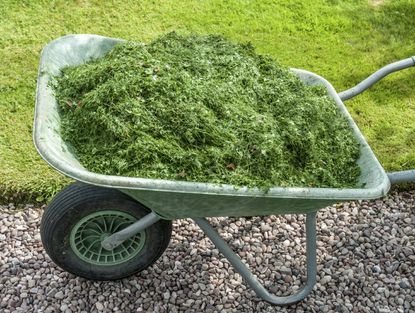Mulching With Grass Clippings: Can I Use Grass Clippings As Mulch In My Garden


Can I use grass clippings as mulch in my garden? A well-manicured lawn is a sense of pride to the home owner, but leaves behind yard waste. Certainly, grass clippings can perform a host of duties in the landscape, adding nutrients and keeping your yard waste bin empty.
Mulching with grass clippings, either on the lawn or in the garden bed, is a time-honored method which enhances soil, prevents some weeds, and preserves moisture.
Grass Clipping Garden Mulch
Fresh or dried grass trimmings are often collected in the lawnmower bag. This heap of green can simply go to your municipal compost facility if you have one, or you can use them to help your landscape.
For us truly lazy gardeners, leave the bag off and just let the clippings do their work in the sod. Grass clipping garden mulch is simple, effective, and one of the sneaky ways to benefit from garbage. Lawnmowers with bags became popular in the 1950’s. However, one way to use the clippings that result from mowing is to let them fall on the sod and compost.
Clippings that are less than 1 inch (2.5 cm.) slip down to the root zone of the grass and break down quite quickly into the soil. Longer clippings can be bagged or raked up and mulched elsewhere, as these stay on the surface of the soil and take longer to compost.
The benefits of using fresh grass clippings as mulch include cooling the root zone, conserving moisture, and adding back up to 25 percent of the nutrients that growth removes from the soil. Mulching with grass clippings has the added benefit of taking one more step out of an already drudgery filled garden chore.
Turfgrass clippings contain high amounts of nitrogen, a macro-nutrient that all plants need to grow and flourish. Can I use grass clippings in my garden? This is one of the best ways to use the refuse and the clippings break down quickly and add nitrogen to the soil while increasing porosity and reducing evaporation. You can use fresh or dried grass clippings as mulch.
Gardening tips, videos, info and more delivered right to your inbox!
Sign up for the Gardening Know How newsletter today and receive a free download of our most popular eBook "How to Grow Delicious Tomatoes."
Tips for Mulching with Grass Clippings
When using fresh clippings as mulch, lay a layer of only ¼ inch (6 mm.) thick. This will allow the grass to start to break down before it begins to smell or rot. Thicker layers have a tendency to remain too wet and can invite mold and create smelly decay issues. Dried clippings can go on thicker and make excellent side dresses for vegetable crops.
You can also use grass clippings to line paths in the garden to keep down mud and prevent weeds in exposed dirt areas. Late fall to early spring grass clippings are excellent for helping you juice up the garden bed. Mix them into the soil to a depth of at least 8 inches (20 cm.) to add nitrogen.
For a balanced garden soil amendment, add a ratio of two parts of carbon releasing organic amendment for every one part of nitrogen. Carbon releasing items such as dry leaves, sawdust, hay, or even shredded newspaper aerate the soil to introduce oxygen to bacteria, prevent excess moisture, and compliment the nitrogen.
Dried grass clippings mixed with two times as much dried leaf litter will create compost with a healthy balance of nutrients and will break down quickly due to the correct carbon to nitrogen ratio. The proper ratio avoids such issues as smells, mold, slow decomposition, and heat retention while allowing you to use up the nitrogen rich grass clippings. In lieu of mulch, you can also compost your grass clippings.

Bonnie Grant is a professional landscaper with a Certification in Urban Gardening. She has been gardening and writing for 15 years. A former professional chef, she has a passion for edible landscaping.